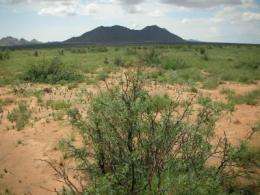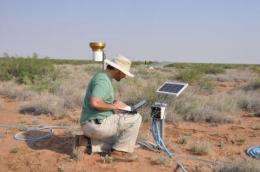Disappearing grasslands: Scientists to study dramatic environmental change

The Earth's grasslands and savannas are experiencing a major transformation as woody plants, such as trees and shrubs, have begun to dominate arid lands around the globe. While ecologists document this dramatic change in vegetation — considered by many to be desertification, or a deterioration of the environment — researchers at Arizona State University suggest these changes may not be completely detrimental.
In a new two-year investigation funded by the National Academies Keck Futures Initiative, ASU scientists will study the effects of woody-plant encroachment on multiple ecosystems. They will collect data from grasslands in Kansas and New Mexico, as well as use existing, collected data.
"Is this really degradation or is it simply a change in the portfolio of services the ecosystem is providing?" asks Osvaldo Sala, professor of ecology and sustainability in ASU's School of Life Sciences and School of Sustainability. "If the second is true, there may be a shift among stakeholders who win and who lose as a result of this change."
Ecosystem services are basically the things ecosystems provide to humans such as food, wood, fiber, conservation, recreation, carbon storage and clean water. These services are often compromised when drastic environmental transformation occurs.

Woody-plant encroachment of arid lands is a phenomenon occurring around the world — from the United States to Africa, and from South America to China. In an ongoing effort to try to restore arid lands to their previous states, the U.S. government is using herbicides and machinery to eradicate shrubs and trees — and spending millions of dollars to do so.
The Arizona State University scientists suggest findings from this study may add new information to the current controversy over whether this is effective land management.
"We'll be using an interdisciplinary approach to identify several things," said Sala. "We need to understand the effects of woody-plant encroachment and the consequences of what is happening from an ecological, economic, and social perspective. And, we need to understand how these changes vary around the world. Once we understand that, our findings may suggest how to manage our grasslands to meet different stakeholders needs. We can try to push the change back, or we can try to take advantage of the good things and mitigate the bad."
The Keck Futures Initiative grant is aimed at filling a critical gap in funding for research on new ideas. With the $75,000 award, researchers will assess nine ecosystem services provided by grasslands both before and after woody plants began taking over. They will specifically study tallgrass prairie in Kansas and the Chihuahuan Desert grassland in New Mexico.
Sala, who is the Julie A. Wrigley Chair and Foundation Professor, and a Distinguished Sustainability Scientist with the Global Institute of Sustainability, will begin research with his team this fall.
Scientists working with Sala include Billie Turner, professor in the ASU School of Geographical Sciences and Urban Planning, and School of Sustainability; and Elena Bennett, assistant professor at McGill University.
Provided by Arizona State University



















